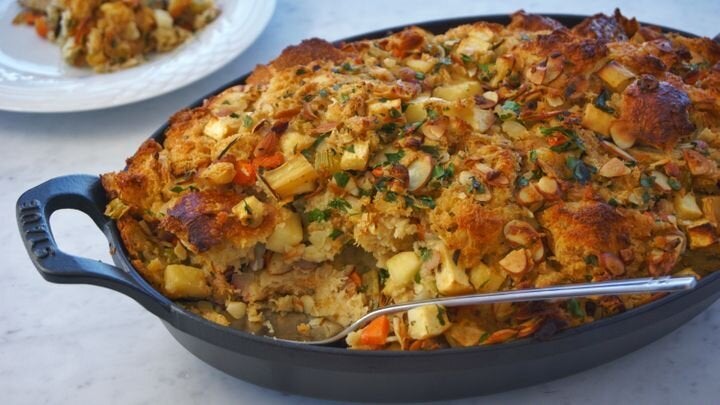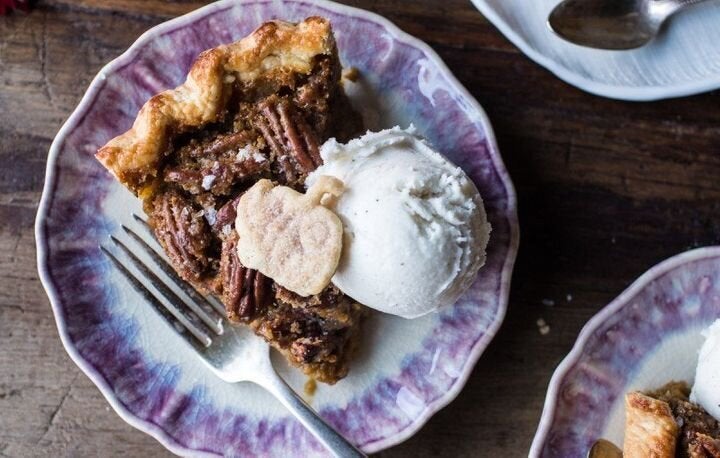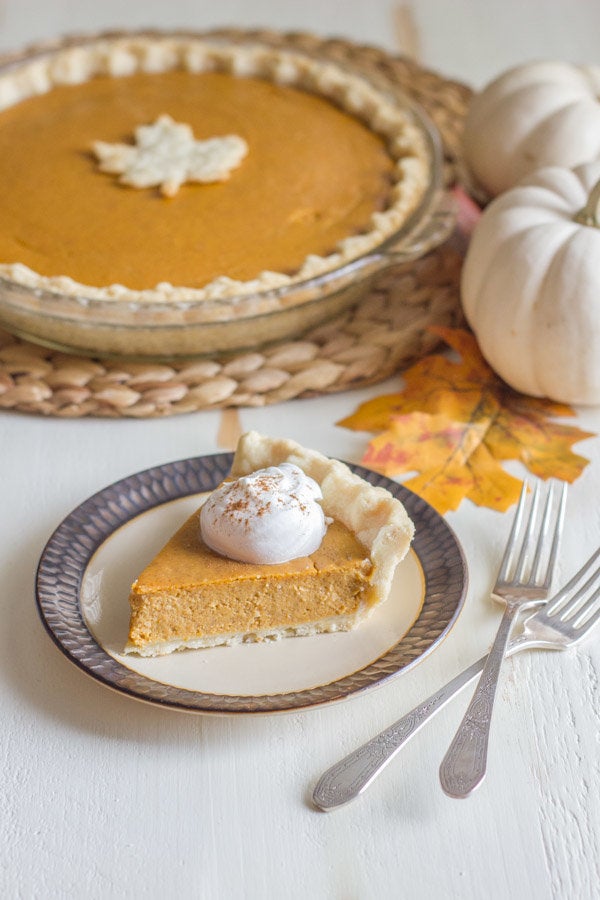Everything Thanksgiving: Get all our Thanksgiving recipes, how-to’s and more!
Thanksgiving is that wonderful time of year when we gather with friends and family, test the limits of butter consumption, eat an inordinate amount of potatoes and regurgitate trivia that may or may not be true.
While we can’t help you with the obscene amount of butter you’re about to go through, we can lend a hand with some of those trivial Thanksgiving tidbits that have been clawing at you over the years. Let’s get started with the debunking: Here are some popular myths about cooking techniques, nutrition and tradition.
Cooking Myth #1: Cook Your Turkey At 350
Just because you eat turkey at Thanksgiving doesn’t mean you do it correctly. The target temperature for safety is 165 F, and that’s universal. But the journey to completion is the important step.
The USDA recommends cooking the turkey at no lower than 325, and you will often see recommended temperatures ranging below 400, such as here, here and here.
Experts advise turning up the heat to yield a far juicier bird.
Head butcher and chef Rob Levitt of Chicago’s butcher shop and cafe Publican Quality Meats sets his oven to 500 for the first half-hour before turning it down to 325.
Ian Rynecki, executive chef of the Tasting Room at Pippin Hill Farm and Vineyards in North Garden, Virginia, is here to save your day: “The longer [it takes to] cook, the drier the bird gets ― typically, you’re not braising here ― so I suggest a slightly higher temp, 425.”
Cooking Myth #2: Stuffing The Bird Is A Sin
We all know the rules. Don’t talk politics. Don’t double-dip and don’t ever, under any circumstances, stuff your turkey. (Undercooking stuffing ― which contains raw eggs ― inside a raw bird can result in some nasty food poisoning.)

Kyle Bailey, executive chef of Washington, D.C.’s The Salt Line, has a simple fix for those who want the benefit of juicy stuffing.
“Because the stuffing needs to reach a safe temperature, the breasts of the turkey become dry in the process,” he told HuffPost. “You can still use stuffing in your turkey. I would recommend warming it up in advance so that it’s not as cold when you stuff the bird.”
And the stuffing itself doesn’t have to be the dish everyone passes around the table without trying.
“Stuffing tends to get a bad rap due to the ‘easy bake’ stuffing mixes,” Rynecki said. “You’re not buying instant or premade mashed potatoes are you? Treat your stuffing in the same way. Use quality leftover bread, season it with homemade protein stock (chicken, turkey, beef, mushroom) and add a lot of fresh herbs.”
Cooking Myth #3: Cook The Entire Turkey
Tradition is nice and all, but nobody is eating the entire turkey as if it were a giant drumstick anyway. That bird is going to get sliced and diced, so you might as well use that to your advantage.
“I think the only way to cook a Thanksgiving turkey is to spatchcock it — I do it every year,” said chef and partner Tony Mantuano of Chicago’s Spiaggia and Maddon’s Post. “This basically means you take out the backbone, butterfly the turkey open, and crack the breastbone so it lays flat and cooks evenly. I just think the process of spatchcocking makes it cook really, really evenly.”
Sébastien Giannini, the executive chef of Kingbird at The Watergate Hotel in Washington, D.C., echoes that sentiment. “Break it down,” he implores. “A full cooked turkey is a nice visual, but cooking it all the way through can lead to dryness. It’s better to break it down and allow everything to cook more consistently.”
Cooking Myth #4: Turkey Is Just A Bland Bird
Eating a ridiculously huge bird can sometimes seem less of a tradition and more like an exercise in going through the motions, especially when we take dry turkey for granted.
“Turkey should never be bland or dry,” said executive chef Eric Lees at Spiaggia. “The problem is that people take it out of the oven way too soon. Make sure your oven thermometer is calibrated and you’re cooking the bird long enough. Don’t cut into it right away, either — let the turkey rest for at least 25 minutes after cooking, no matter how large the turkey is. Another hack is to use those nice pan juices and baste over the sliced meat (versus basting before cooking) to avoid soggy turkey skin.”
Levitt has a carefully crafted turkey schedule, and it includes taking the bird out for plenty of carry-over cooking. He recommends that you “roast until the thermometer registers 155 degrees F.”
And then the most important step is to walk away. “I like to cook my turkey very early in the day and let it rest until it is room temperature.”
Nutrition Myth #1: Tryptophan Is Knocking You Out
There are two givens at any holiday dinner. Someone will inevitably push away from the table in defeat and remark at how they are not only full but feel like enjoying a nice food coma. That is when another person, tipsy on wine and food trivia, will chime in, “You know that’s the tryptophan that’s making you sleepy.”
This is your cue to be the “well, actually” person at the table. Turns out, tryptophan making you sleepy is a bit fat lie.
“While tryptophan deserves some of the credit for post-meal slumber, as the body converts it to melatonin, there are other factors that play a more significant role in this Thanksgiving tradition,” explains nutritionist and Candida Diet expert Lisa Richards.
“First, eating a large meal requires a significant amount of time to digest,” Richards told HuffPost. “The body sends a great deal of oxygen-carrying blood to the digestive tract to help speed along the process.”
This means there’s less blood to go around for places like that brain of yours that’s now shutting down. And don’t forget that when you overindulge you see a noticeable spike in blood sugar, which precedes an epic crash.
“This crash in blood sugar, as a result of increased insulin production, makes us very tired post-meal,” Richards said.
Nutrition Myth #2: This Massive Holiday Meal Will Annihilate Your Diet
What you just did at the dinner table, while highly commendable on a competitive eater level, isn’t the end of the world from a diet standpoint.

“One big meal will not make you fat, and one good workout will not make you fit,” explains celebrity chef and author of “Eat Like You Give a Fork: The Real Dish on Eating to Thrive,” Mareya Ibrahim. “It doesn’t work that way. Like I talk about in the book, the 90/10 rule encourages you to eat a couple hundred extra calories a few times a week to ‘exercise your metabolism’ and stoke the fire as a 10% to the 90% of the time you’re eating whole, nutritionally balanced foods.”
Ibrahim placates that holiday guilt: “That Thanksgiving binge is not going to break the bank, because it’s such an infrequent occurrence.”
Ibrahim actually recommends flipping the script on how many calories you take in on a regular basis: “You need to mix it up to get results.”
Richards has a similar thought on this indulgent holiday.
“Having one meal a year, or multiple, where you allow yourself to indulge your cravings and satisfy your sentimental food desires will not lead to weight gain,” she says. “In fact, allowing yourself to indulge occasionally, and by this I mean very rarely, will likely make your healthy eating pattern more sustainable, leading to better overall health and maintaining weight loss throughout the year.”
Nutrition Myth #3: The Desserts Are The Worst Part Of The Meal For You
It’s cute and all that you think the pies are the worst part of the meal, because the entirety of your Thanksgiving menu is a gantlet of culinary landmines just waiting to demolish all the commendable steps you walked that week.
When asked what to watch out for, Richards states, “In a word: casseroles.”
The reason is simple. “Most casseroles are loaded with refined carbohydrates and very little in the way of nutrient-rich ingredients,” she said. “They are typically all on the same color scheme, light brown and are loaded with fat from creams and butter.”
“The desserts are usually where the calorie glut happens, because it’s heavy carbohydrates combined with sugar,” Ibrahim notes. “But there are also suspects lurking in the veggies. Bacon drippings in the gravy. Deep-fried Brussels sprouts. Lots of melted cheese in the au gratin potatoes.”
And when it comes to white versus dark meat, a poorly cooked bird can do you in.
“There are more fat and saturated fat in the dark meat, but usually, people add more fat like gravy and butter to the white meat to make it moist since it tends to be more dry,” she said.
So help your guests’ diets and cook a delicious turkey.
Historical Myth #1: The Very First Thanksgiving Was In 1621
From the moment we made those silly paper turkeys to take home to our parents in grade school, we were told that the first Thanksgiving was a festive gathering between the Pilgrims and the Wampanoag Indians at the Plymouth Colony in 1621.
Harvest festivals in one form or another predate that fine occasion. It was common for Europeans to gather and give thanks to a bountiful harvest prior to any Pilgrim landing. When it comes to the date we have all been told, food historian and proprietor of the A Taste of History website, Joyce M. White, explains that the famed meeting was, “certainly not the first on North American soil.”
One event that precedes the Pilgrims’ meal is that of the settlers at Berkeley Hundred in Virginia, which took place two years prior.
“Much like the Pilgrims at Plymouth, they had a very rough journey to get to the Chesapeake Bay area. And they landed there in 1619,” White said.
As for what they may have had for that epic feast, White explains, “whatever was left over from the journey, which probably wasn’t much.” But it would have included local fresh oysters among other locally sourced proteins. Hey, just like your favorite farm-to-table restaurant.
Historical Myth #2: Turkey Was The Main Attraction For The Pilgrims
If you’re going to consider the Pilgrims and 1621 as the quintessential Thanksgiving beginning, then you should know that the menu was all over the place.
It’s difficult to track down exactly what was had, but thanks to sources like Plymouth Gov. William Bradford’s writings along with musings by settlers like Edward Winslow in Mourt’s Relation (1621), there is some inkling as to what was enjoyed. And it wasn’t solely turkey, although that would have been present with the caveat that the birds today are larger.
“It would have been very common to have three or four, maybe even more, proteins on your table,” White said. Beaver, otter and myriad fowl would have played a role.
But if you want to replicate the awe and grandeur of that historic meal then get out and hunt some deer. Venison and the act of hunting the meat would have been the apex of celebration.
“Deer meat at that time for British people was a luxury item. In England that was something that royals were only really allowed to have,” White said. “You would pay for your life if you poached a deer.”
In the New World, things were different; deer were abundant and there were no royals in sight.
Historical Myth #3: You Can Thank The Pilgrims For Your Pumpkin Pie
We are waist-deep into decorative gourd season. For the span of a couple of months we go pumpkin insane, attempting to cram every last vestige of the rotund gourd into our coffee, pasta and, yes, pies.
But it’s all because those early harvest celebrations were centered around agrarian bounty and the specialty of the pumpkin that was ubiquitous at the time. Well, not so much.
Pumpkins took a long, winding road to end up on our tables and doorsteps and in our pies. But when it comes to the pumpkin, there is a reason we associate this squash with the season.
“Americans have relied on the pumpkin for a really long time to maintain their connections to rural farm life, which they always kind of held in the back of their minds as this idyllic way of making a living,” explains Cindy Ott, an associate professor of history at the University of Delaware and the author of “Pumpkin: The Curious History of an American Icon.”
Ott started her work with a simple quandary: What’s the deal with pumpkins? As it turns out, it has less to do with Pilgrims and more to do with our national inclination to romanticize agrarian life.
Colonial settlers had to eat whatever was available to them, and often that meant squash, pumpkins or melons — a term that was interchangeable for either.
But it wasn’t until the mid-19th century that pumpkins finally had their day.
“People move into cities and they get stressed about losing their connections to farm life,” Ott said. “Pumpkin has no economic value in the marketplace but then it starts to appear in Harper’s Weekly and then Winslow Homer paintings, and then it becomes the center of this new national holiday that’s created.”
Around that same time, families were used to eating squash, but pumpkins were relatively useless: “Now the round, orange pumpkin, that was bigger, more awkward, wasn’t quite as sweet, so it never became the same as a market crop in the city.”
Rather, pumpkins were used as cheap and bountiful livestock feed, the crop that was left on the farm. And this is where it slowly but surely saw its status rise from also-ran gourd to the symbol of autumnal bounty.
